by EarthSpirit Community on EarthSpirit Voices
Written by Katie LaFond

I celebrate the Earth as Sacred, and it started me down a path many years ago that has borne some surprising fruit. Below is a collection of simple things you can do to help live more lightly on the Earth. I consider each of these an act of prayer.
The tips are organized into 12 steps. A lot of these cross over, but this will get you started. Focus on one section at a time.
Do these at your own pace. With 12 sections, you can choose to focus on one area for the amount of time that feels right to you. If you find the pacing too fast/slow, you can always modify your habits. The point here is to see how easy it can be to weave some of these into your life. Remember that this blog post is only the beginning. This can be a lifestyle change, and will take you on interesting adventures along the way. Every drop in the bucket makes a difference.
- Get serious about Recycling
- Get serious about Reusing
- Get serious about Reducing
- Start Composting
- Use your car less
- Locate your local food options
- Where do your things come from? Try to source as many of the things you use within a 100 mile radius of your home
- Start a garden
- Look into buying “Environmentally Friendly” products.
- Energy consumption
- Get Crafty
- Educate yourself
A Year of Drops Step 1: Get Serious About Recycling
-
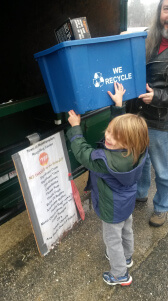
Recycling! Photo by Katie LaFond Many communities have curbside recycling or transfer stations that accept recycling. Utilize these options
- Grocery stores often have plastic shopping bag recycling stations, as well as bottle and can return facilities
- Electronics stores, like Best Buy or Staples, often accept old electronics for recycling. Go through your basement and drawers for those hidden old electronics that can get recycled which cleans out your house and frees up the resources to make new items
- Aluminum is an example of a resource that is much less costly to recycle than to produce from scratch. Recycling aluminum requires only 5% of the total amount of energy that is used for making new aluminum.
- Paper can be recycled about five to seven times before the fibers become too short to be recycled again, and saves many trees along the way (also be careful not to misprint copies, and to only make what you need… double sided, perhaps)
- No recycling available while you’re out? Put the bottle in your bag, and put it in the recycling bin at home.
- Not sure how to recycle it? Check Earth911.
A Year of Drops Step 2: Get Serious About Reusing
- Reusable shopping bags and reusable produce bags are great. Most of the reusable bags for purchase are made from polyester or plastic (which comes from fossil fuels). Purchase or make reusable bags made of natural fibers (cotton, hemp, etc) that can be composted when they are no longer usable as bags. Free patterns can be found here.
- Use reusable containers instead of plastic wrap. Bring them to restaurants for leftovers too! (I keep some in the car because I’m forgetful)
-
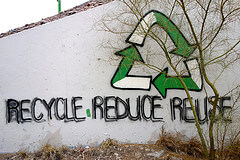
Photo by Kevin Dooley, used under a Creative Commons license Use reusable coffee mugs at the coffee shop. Keep one in your car all the time just in case you have a sudden coffee craving
- Wash your plastic freezer bags to reuse them
- Reuse containers that your food is packaged in. Spaghetti sauce jars can be useful for leftover soup, used as a water bottle, making herbal tea, as a candle holder, and to hold dried beans/nuts/etc.
- Plastic has its place. With a small child, I often use tupperware or rubbermaid containers to send his lunch to school, pyrex having the potential to smash and make an unsafe
situation for the children and teachers. Well-made plastic containers that can be used for decades and then be recycled is preferable to the disposable plastic (or styrofoam) that is often used, even if you recycle it afterward. There are also stainless steel/metal container options that you can research that can be safer for small hands. - Remember that the process of recycling often uses a lot of energy and can release chemicals that are detrimental to the health of the world and ourselves as part of it. It is often better than products ending up in landfills, but reusing is often preferable to recycling.
- Facecloth sized cotton towels/rags in the kitchen for drying hands/wiping up spills can help you avoid using paper towels. Cotton will compost when you’re done with them). Keep a basket of them handy.
- Cotton washing rags to wash your dishes can help you avoid using a petroleum based sponge. It’s also more sanitary, because you can throw the rag in the laundry at the end of the day. It can also be composted when it is no longer useful as a washing rag
- Reusable cotton napkins: keep a basket of them near the table.
- Reusable batteries. (Make sure to read the charging instructions)
- Reusable plates/silverware. My husband and I have a small tote that we use to transport 20 plates, cloth napkins, and sets of silverware with us when we attend potlucks. The used dishes go back into the tote to come home with us, and the tote then serves as a dishpan. We wash the dishes, let them dry, and then they go back into the tote to await the next potluck.
- You can also bring your own plate/napkin/silverware with you when you attend potlucks. Metal pie plates can be very useful.
- Cloth diapers. If you have a baby, cloth diapers are a great way to reduce the amount of trash you make. Bonus: it saves money! Borrow some prefolds, a variety of covers or soakers, and perhaps some “all-in-one” type diapers to determine your favorite type. See if any of your friends have some you can use, or look on Freecycle/Craigslist to buy your diapers. Washing them is not hard. Be sure not to use traditional detergent which can waterproof what we hope will be absorbent. Here is one resource.
- Reusable menstrual pads, and menstrual cups. A little pricey, but once purchased, you don’t have to buy products each month, and washing them yourself, you don’t have to worry about what chemicals are contacting your skin. Many different options are available, google “reusable menstrual pads and cups.”
A Year of Drops Step 3: Get Serious About Reducing
-

photo by Bill McChesney; used under a Creative Commons License When you throw things “away,” remember that there is no such thing as “away.” Where does it go?
- Rinse the trash you DO throw away, so that your barrel does not smell, and you can go longer between using a new (often plastic) trash bag.
- When possible, buy things in bulk to reduce the amount of packaging you’re also buying with the desired product. You can bring a cotton produce bag for bulk items.
- Make a list of everything that goes in your trash and recycling, and determine one thing each week you can stop buying that makes trash. Packaging accounted for much of my waste. Buying things in bulk and at the local farmers’ markets (I’m lucky enough to have both summer and winter farmers’ markets) cut down on much of the packaging I brought home and immediately threw away.
- It often seems cheaper and easier to just “buy a new one” for example, the drip trays underneath the burners on your stove. They can get really gross! It’s tempting to throw them away and put new ones in, but be aware of the hidden costs to yourself and the world… Soak them in baking soda and water overnight, and clean them. The more often you wash them, the less work it is.
- Water usage: turn it off! Even in water-rich areas like the Northeastern US, using water requires energy to run the pump, the water heater, etc. When you brush your teeth, don’t let the water run. I like to fill up a glass which I use to wet and rinse my toothbrush. Using a cup of water, as opposed to a gallon, makes a difference. When shaving, put a little water in the bottom of the sink instead of letting the water run.
- Consider showering by running the water just long enough to get wet. Turn it off, soap up, and then turn it back on for just long enough to rinse. If you enjoy the feeling of soaking in warm water, consider a long bath. (If you’re indulging in a bath, make it worth the water usage: relax for a half hour or more.)
- Make sure when you are doing laundry, do a full load. Doing half a load of laundry uses almost as much water and energy, but be aware; overstuffing your washer is also inefficient.
- Get into “shabby chic.” Freecycle and craigslist are a great way to make sure your unwanted items stay out of trash heaps. Acquiring the things you want and need using Freecycle or similar is also a good way to support the reusing effort. Older items can work just as well, and can add a rustic look to your house.
A Year of Drops Step 4: Start Composting
-

Photo by Joi Ito, used under a Creative Commons License Lots of resources are available if you are interested in learning how to compost. This is just one of many educational websites that are easily found.
- Compost tumblers can be an interesting option to explore, particularly in urban and suburban areas.
- Many towns also offer covered compost bins for purchase with the cost partially subsidized by the town. This can help composting happen a little faster and keep critters out of your pile. Check your town’s website to see if yours is one of them!
- If you don’t have a compost heap, bring your compost to a friend’s heap. I did this for quite a while when I lived in an apartment in the city.
- Some places will take your compost drop off. If you live in a city, check to see if there is a municipal composting program.
- If you want to compost your meat and oil, you have to get a little more advanced in your composting skills. Talk to your local expert if you’re interested in this.
- If bugs (e.g. fruit flies) are attracted to your compost, you can keep your bucket in the fridge
- Consider starting a worm bin. This can be a good option if you’re in an apartment, and can double as entertainment (worms!) if your child is like mine.
A Year of Drops Step Five: Use Your Car Less
-
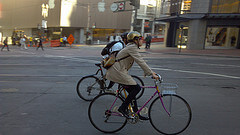
Photo by Luxomedia, used under a Creative Commons License If you’re near your workplace, ride your bike. Keep your clothes in a bag and change at work.
- If you’re near the places you do your errands, ride your bike. Child bike trailers can be handy for hauling groceries. I had a tricycle with a basket on the back which was a great grocery-getter.
- Combine trips. I do much of our household shopping on my way home from work.
- If you live in an urban area, consider public transportation or walking for short trips.
- Can you carpool? Some offices help arrange car- or vanpools too. Ask your HR department about it.
- Do you have “stuff” in your car? More weight means reduced gas efficiency. Roof racks create drag, and reduces gas efficiency. If you can remove it and only use it when you need it, consider it.
- When replacing your car, consider a more gas efficient car.
A Year of Drops Step 6: Locate Local Food Options
-

photo by Sarah Rosehill; used with permission Local farmers will often let you use your own containers, reducing the amount of plastic you take home
- Eating locally can allow you to develop a relationship with the land, animals, plants, and farmers that feed you and your family. Feeling a connection to that which nourishes us is something that my family cherishes. We take a moment to give thanks before eating, often saying our farmers’ names aloud.
- Farmers’ Markets can be found in many communities during the summer and even the
winter. I have even found Farmers’ Markets on the Mass Turnpike! - Helpful resources: CISA, Local Harvest.
- Eat food that is in season. It is often available more locally, and connect you to the cycles of the land where you live. For example, where I live, I eat asparagus and fiddleheads in the early spring, broccoli in the spring, peas in the early summer, zucchini in the summer, tomatoes in late summer, squash and apples in the fall, and root vegetables (onions, potatoes, beets, carrots) over the winter.
- Join a CSA or two. Veggies, meat, milk and cheese shares are widely available in both the city and rural areas.
- If you have the space, start a garden. Nothing is more local than your back yard! There are lots of great resources for beginning gardeners available for free online. Start by growing just one or two of your favorites.
- Be brave! Take a new food home each week and learn how to cook it. If you don’t like it at first, try one bite each day for a week. Taste can be acquired.
- It may be more expensive to eat locally, but remember that it doesn’t need to be shipped long distance and buying local food stimulates the local economy. “Cost” is so much more than a price tag.
- Cook big batches, and package meals in reusable containers (repurposed spaghetti sauce jars) to freeze for nights that you’re tempted to get take out. Remember to leave a little space at the top of glass jars before freezing!
- Processed foods come in a lot of packaging. Eating less processed food will significantly reduce your waste stream (and improve your health).
A Year of Drops Step 7: Buy Local
Where do your things come from? Try to source as many of the things you use within a 100 mile radius of your home, and choose options that are in line with your values.
-
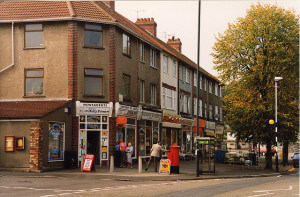
Photo by Richard Walker, used under a Creative Commons License Candles are often made of paraffin, which comes from fossil fuels; look for beeswax instead.
- Buy what you can locally. Not only does it stimulate the local economy, it means that items aren’t being shipped cross-country to your home, which burns fossil fuels.
- Large companies have the benefit of established infrastructure to efficiently move
materials, but they are often moving them long distances, burning fossil fuels. If your item is not available at smaller, local shops, check freecycle, craigslist, and your circle of friends before buying an item that is being shipped long distances. - Support your local artisans! Many old arts (soap making, candle making, cider pressing, and more) are being reclaimed, and each time we choose to buy locally, we’re supporting the kind of communities we want to live in.
- Do you often have items shipped to your house? While it is convenient for our busy lifestyles, it means that fossil fuels are being burned to ship things to your house. Try to combine shipped purchases into larger orders to reduce the number of trips being made to your house. Currently, I’m working hard at this, as I struggle with my love of Amazon Prime and Groupon.
A Year of Drops Step 8: Start a Garden
Your own yard is the most local food possible!
-

Photo by Irene Kightley, used under a Creative Commons License Inside: put containers (pots, window boxes) in your southern facing windows. Herbs and small things like carrots and bush beans work well.
- Your local garden center can help you learn how to care for your plants. Consider your soil and make sure it has enough drainage.
- Outside you have a lot of options. You can make your garden as complicated or simple as
you’d like. Start small, add to it each year, educate yourself, read lots of books and ask for help. - You can have your soil tested for contaminants cheaply, usually through your local university extension center. In Massachusetts, UMass does this.
- Container gardens can be a great option for those in condos or apartments. These can be in or outside, and depending on the size of your container, can be as simple or complex as you’d like.
- Rooftop gardens are quickly catching on in the city. Community gardens are also popular.
- Start with easy to grow items: beans, tomatoes, carrots, garlic, and squash like zucchini and butternut.
- Plant bee- and butterfly-friendly plants like milkweed, bee balm, black-eyed susans and sunflowers to keep your local bee populations fed and healthy
- Buyer beware: pesticides are sometimes present in plants you can buy. Last year I was dismayed to learn that there were plants for purchase at a large popular store that kill bees when they visit them. Visit a local garden center where you can talk to an expert and get ideas. It might be a little more expensive in the moment, but well worth it in the long run.
A Year of Drops Step 9: Look into Environmentally Friendly Products
-
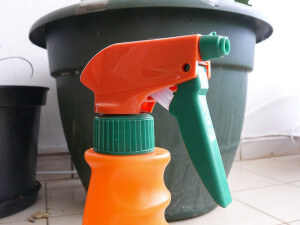
Photo by Arria Belli, used under a Creative Commons License Be aware that being “eco friendly” is now a fad, and a marketing scheme. Don’t be sucked in.
- Many times, you can make your own cleaning products. Baking soda, washing soda, borax, water, and vinegar are great natural solvents. (But be careful when mixing baking soda and vinegar, unless you’re doing a science fair project!). Here’s one resource; there are many
online. - Try castile soap in the shower, as hand soap, and as dish soap. You can even use the bars to make your own laundry detergent!
- You can make many personal care products using recipes found online. This lets you know exactly what’s in it and avoid ingredients derived from fossil fuels.
- If you have a septic tank, avoid using products that will kill the natural flora like bleach. The flora will break down your waste naturally, allowing it to cycle back into the ecosystem.
A Year of Drops Step 10: Examine Energy Consumption
-
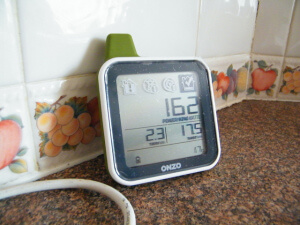
A home energy meter. Photo by Digitpedia.com; used under a Creative Commons License What sorts of energy do you use? Electricity can often be traced back to fossil fuels, but if you look into solar or wind options for your home, you can reduce some of that. You can also specify with many electric companies that your energy come from renewable sources.
- You can rent solar panels for your yard. They don’t have to be on your roof, but if you have a southern facing roof, go ahead and research options for that.
- Consider elbow grease, or being more steampunk: electricity is not the only kind of energy out there. When cleaning using natural cleaning products, you often have to use a
little more elbow grease. Consider it exercise! - If you have a woodstove, check to see how efficient it is. Sometimes, incentives are offered for upgrading to a more efficient stove. Efficient wood stoves and pellet stoves can be a great way to heat your home without using fossil fuels (remember to keep your chimney clean to avoid chimney fires). Fans are also available to circulate hot air that run on the heat power coming from your stove already.
- How much energy do you use? Consider converting to an “on demand” water heating system, so that you’re only using energy to heat water when you need it, and not to keeping a full tank of water warm when you don’t need to
- How hot/cold do you need to keep your house? Slippers, robes, and sweaters are cozy in the winter, allowing you to keep your home a little cooler, and a fan can help you stay comfortable with warmer temperatures in the summer.
- Programmable thermostats are available if you have a thermostat in your home. Bringing the temperature down 6 degrees at night can save a lot of energy. Much more than that doesn’t save as much energy as those first 6 degrees. If you’re away at school/work during the day, consider keeping the temperature low during those hours as well. Set the thermostat to warm up a half hour before you typically get home so that it is comfortable when you arrive. The best part about this option is that you can “set it and forget it.” It is a seamless drop in the bucket that takes a minimum of effort.
- Dryers are a huge energy consumer. They also slowly degrade your clothing, meaning you need to purchase new clothing sooner, which is also wasteful. Hanging your laundry inside/outside is much more efficient, and adds humidity to dry winter air inside your house. I use a retractable 5-line in the house.
- When replacing your light bulbs, consider CFL, or LED bulbs. Be aware that CFL bulbs contain mercury. Recycle them properly.
- Turn off lights when you’re not using them. Consider lower lighting in your home unless you’re reading or doing detailed projects. Consider burning a beeswax candle at night instead of using a lamp, and reconnecting to the cycles of light and dark through the year.
- Power strips will draw energy even when there is nothing plugged into them. They often come with switches; turn off your power strips when you’re not using them.
- Most chargers (phone, tablet, kindle, laptop) also draw energy even when your items are not plugged into them. Despite it being only a “trickle” of energy, it adds up, home to home. Unplug them when you’re not using them.
- Turn off the heated dry cycle on your dishwasher. Open the door at the end of the cycle and let them air dry
- Wash your laundry on a cold/cold cycle unless hot water is necessary to get them clean. Towels and diapers benefit from a hot cycle, but otherwise, laundry gets clean on a cold/cold cycle
- Many electric companies will do an energy audit for your house to help you learn where you could be more efficient.
A Year of Drops Step 11: Get Crafty
-
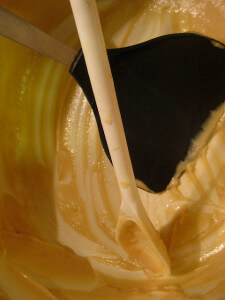
Photo by Tabatha Alcina, used under a Creative Commons license Learn to cook, sew, knit, spin, make soap, make detergent, make candles, keep bees, can food, make cheese
- Slow cookers and pressure cookers simplify a lot of home cooking and
allow you to make your own “convenience food.” - Keep your meat bones and use them to make broth. You can keep them in the freezer until you’re ready to make broth. Also consider keeping onion skins, carrot tops, and other food waste that can add complexity and nutrition to your broth
- Keep in mind that in any area where you know how to make your own, you’re a more informed consumer
- Split the work up and share your responsibility with your housemates or family
- Create reminders for yourself so you can keep up on periodic tasks: google calendar alerts, sticky notes…
- Organize your house to make it easy to do all these things: keep baskets of rags in your kitchen and a couple of recycling buckets handy so you can sort as you go. Hanging them vertically on the wall with hooks can be super handy.
A Year of Drops Step 12: Educate Yourself
-

Photo by Randy Adams, used under a Creative Commons license Read books like Garbology, Cradle to Cradle, The Backyard Homestead and Rubbish!
- Go to lectures and workshops
- Places like The Haberdashery, and even the mass.gov website have many great classes you can take to learn new skills
- Join movements! If you want to be included in emails about upcoming events, please email us at earthspirit@earthspirit.com
- Lead by example. Not all activism is marching. If your friends and family ask about your new habits, you have some experience now. Tell them about your experiences, reference the materials you’ve used, or you can direct them to this blog post to get started themselves.
